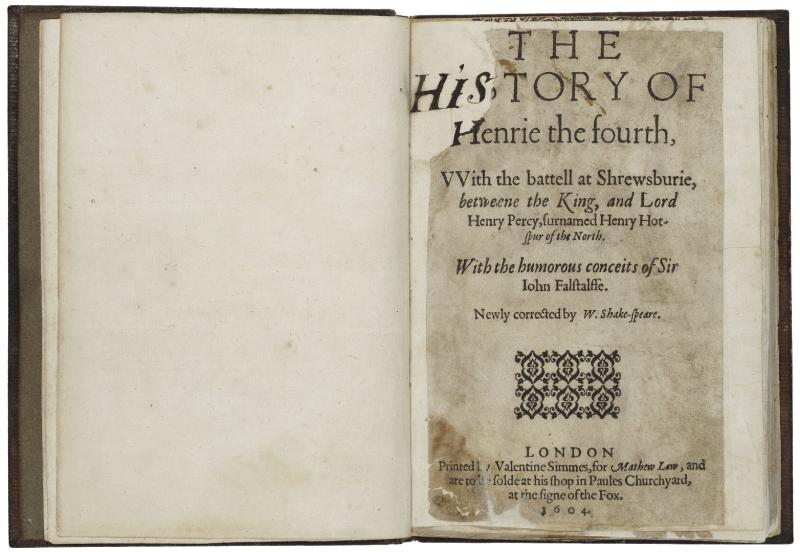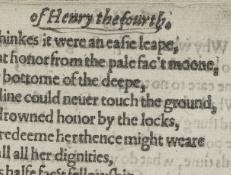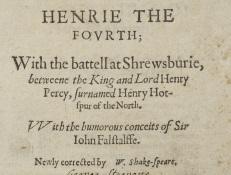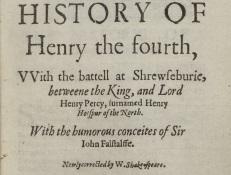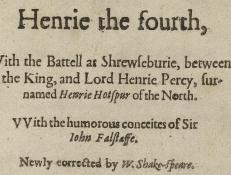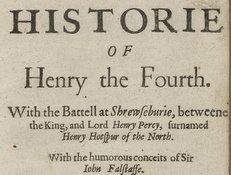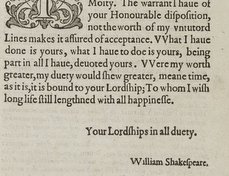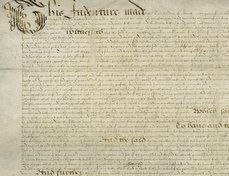Terms of use
Images that are under Folger copyright are licensed under a Creative Commons Attribution-ShareAlike 4.0 International License. This allows you to use our images without additional permission provided that you cite the Folger Shakespeare Library as the source and you license anything you create using the images under the same or equivalent license. For more information, including permissions beyond the scope of this license, see Permissions. The Folger waives permission fees for non-commercial publication by registered non-profits, including university presses, regardless of the license they use. For images copyrighted by an entity other than the Folger, please contact the copyright holder for permission information.
Copy-specific information
Creator: William Shakespeare
Title: The history of Henrie the fourth : vvith the battell at Shrewsburie, betweene the King, and Lord Henry Percy, surnamed Henry Hotspur of the north : with the humorous conceits of Sir Iohn Falstalffe [sic] / newly corrected by W. Shake-speare.
Date: London : Printed by Valentine Simmes, for Mathew Law, and are to be solde at his shop in Paules Churchyard, at the signe of the Fox, 1604.
Repository: Folger Shakespeare Library, Washington, DC, USA
Call number and opening: STC 22282, title page
View online bibliographic record
Justin Kuhn, "Henry IV Part 1, third edition," Shakespeare Documented, https://doi.org/10.37078/249.
Folger Shakespeare Library, STC 22282. See Shakespeare Documented, https://doi.org/10.37078/249.
Matthew Law published the third, fourth, fifth, and sixth editions of Henry IV Part 1. According to the Stationers' Register, Law received the rights to Henry IV Part 1, Richard II, and Richard III from their previous owner Andrew Wise on June 25, 1603. To produce this edition of Henry IV Part 1, Law hired Valentine Simmes, one of the most prolific printers of drama in the period. Simmes had already worked on several playbooks, including first editions of Shakespeare’s Henry IV Part 2 (1600), Much Ado About Nothing (1600), and Hamlet (1603).
Although this is the fourth printed version of the play, it is usually referred to as “Q3” because it is the third quarto to survive fully intact, as only a fragment of the first quarto, “Q0,” has survived. Printed four years after the publication of Henry IV Part 2, this quarto of Part 1 nevertheless retained the standalone title “The History of Henry the Fourth,” omitting any indication that the play was part of a larger work. This is not unusual; for example, the first part of Thomas Heywood’s pair of history plays If You Know Not Me You Know Nobody, or The Troubles of Queen Elizabeth, first printed in 1605, retained its standalone title after the second part was published in 1606. The retention of a standalone title for Henry IV Part 1 suggests that contemporary publishers thought it worked effectively as a self-contained drama. Even though the play was recorded as “Henry the. 4 the firste part” in the Stationer’s Register when Wise transferred the rights to Law in 1603, Law only ever printed the play as “The History of Henry the Fourth.” It would not be printed as Part 1 until the 1623 First Folio.
Law issued several political works prior to publishing Shakespeare's play, suggesting an interest in the issues of political conflict and the divine right of kings. For example, he published William Barlow’s sermon about the late Earl of Essex, who had been executed for leading a failed rebellion against Elizabeth I, A sermon preached at Paules Crosse … With a short discourse of the late Earle of Essex his confession, and penitence, before and at the time of his death (1601), Henry Petowe’s book of poetry, Englands Cæsar (1603), celebrating the coronation of the Queen's successor, James I, and the treatise Summe of the conference before the Kings Maiestie (1604) also by Barlow, describing the Hampton Court Conference, where the King met with clergy to discuss church governance.
The copy shown above, at the Folger Shakespeare Library, is one of five listed in the English Short Title Catalogue. The play is bound with the 1600 edition of Henry IV Part 2 in a volume, previously owned by Sir Thomas Twysden (1602-1683). The next owner received it as a gift from Twysden, according to a note on the back of the title page: “These two plays are particularly esteem’d by me because they were giv’n by me by my Dear Friend [th]e late S[i]r Thomas Twysden of Peckam in Kent, and because [tha]t in this Edition w[hi]ch was publish’d by [th]e Authour, there are several of Falstaff’s Jokes [tha]t are omitted in all [th]e following impressions.” While there is no evidence that Falstaff's jokes were removed from subsequent editions of the play (although oaths were removed with the 1623 folio text), the comment about Shakespeare's involvement in the publication of this edition might have been made in response to the titlepage stating that the text was "Newly corrected by W. Shake-speare.," an editorial pledge which had previously appeared in the second edition of Henry IV Part 1. Such editorial pledges offer key evidence that “Shakespeare was committed to the printing of his plays in corrected and enlarged texts” (Farmer 102). If Shakespeare did furnish the printer an updated version of Henry IV Part 1, he would have at least helped publish the play, even if he was not solely responsible for its publication.
To learn more about Henry IV Part 1, see the Folger 's Shakespeare’s Works, and the British Library’s Shakespeare in Quarto, which also includes information about another copy of this edition.
Written by Justin Kuhn
Sources
DEEP: Database of Early English Playbooks. Ed. Alan B. Farmer and Zachary Lesser. Created 2007. <deep.sas.upenn.edu>.
English Short Title Catalogue (ESTC). British Library. <estc.bl.uk>
Alan Farmer, “Shakespeare as Leading Playwright in Print, 1598-1608/9,” in Shakespeare and Textual Studies, eds. Margaret Jane Kidnie and Sonia Massai (Cambridge, 2015).
Hamnet: Folger Shakespeare Library catalog <hamnet.folger.edu>
David Scott Kastan, eds. King Henry IV: Part 1 (London: Bloomsbury Arden Shakespeare, 2002).
Last updated January 25, 2020

